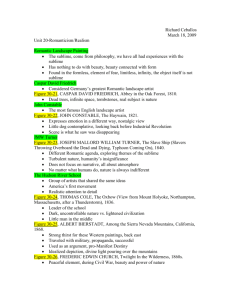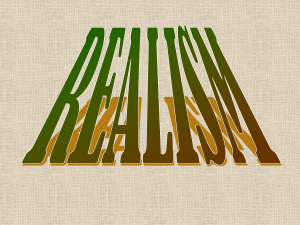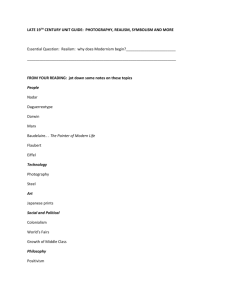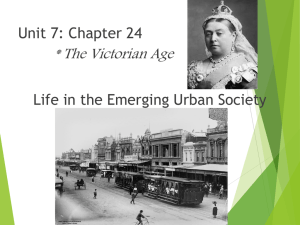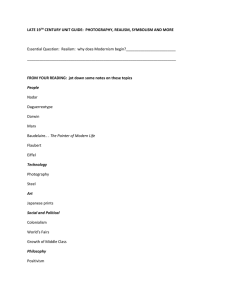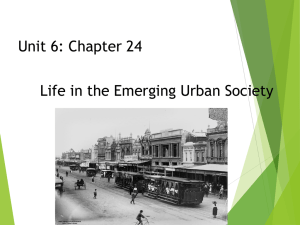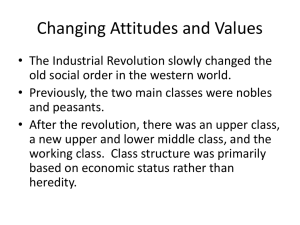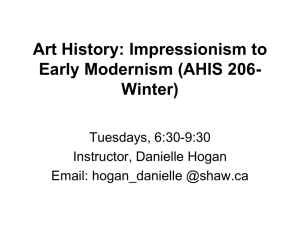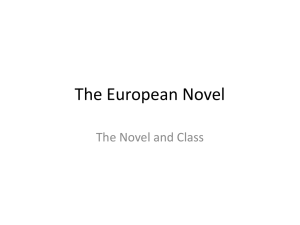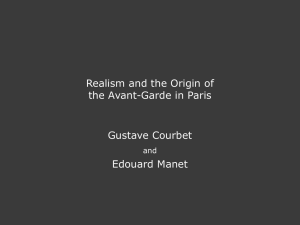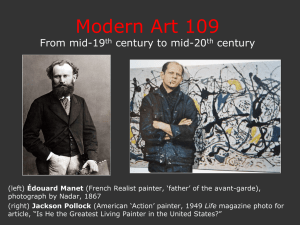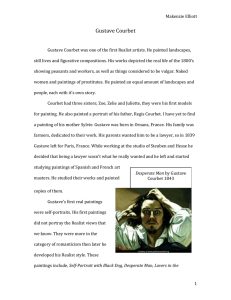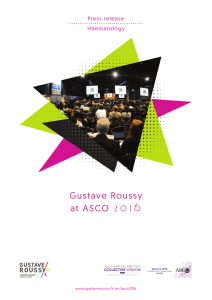Realismslides
advertisement
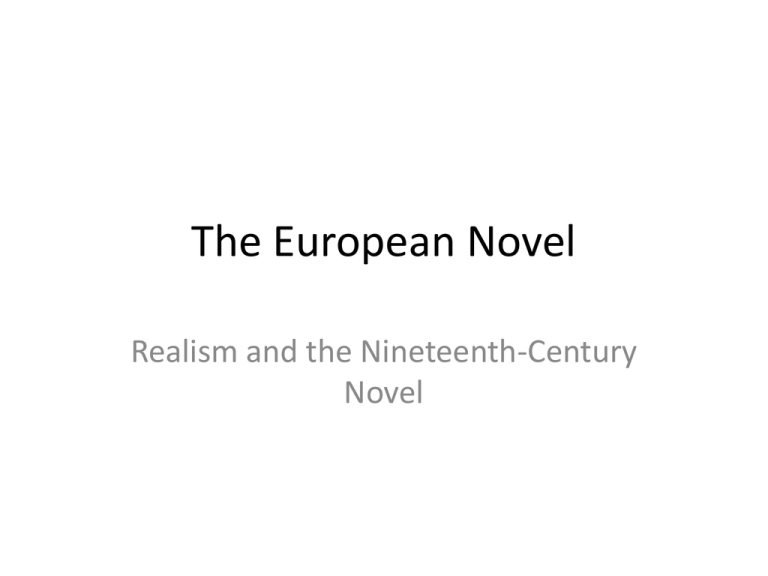
The European Novel Realism and the Nineteenth-Century Novel Gustave Courbet, ‘The Meeting’ or ‘Bonjour Monsieur Courbet’, 1854 ‘I have never seen angels. Show me an angel and I will paint one.’ Painting is an essentially concrete art and can only consist of the presentation of real and existing things. It is a completely physical language, the words of which consist of all visible objects; an object which is abstract, not visible, non-existent, is not within the realm of painting. Gustave Courbet (1861) The ideal is gone, lyricism has run dry. We are soberer. A severe, pitiless concern for truth, the most modern form of empiricism, has penetrated into art. Charles Saint-Beuve (1857) Let us imagine that impersonality is the sign of force. Let us absorb the objective, let it circulate in us, let it reproduce itself on the outside without anyone being able to understand anything about this marvellous chemistry. Our heart must be good only for feeling that of others. Let us be magnifying mirrors of exterior reality. Flaubert, quoted in Roe (1989) Gustave Courbet, ‘Quarryman’, 1850 Gustave Courbet, The Winnowers’, 1855 Jean-Francois Millet, ‘Man with a Hoe’ (1860) Jean-Francois Millet, ‘The Gleaners’ (1857) Édouard Manet, Le Bar des Folies-Bergère (1881) Degas, ‘L’Absinthe’ (1876) Edgar Degas, ‘Portraits in an Office’ (1873) Gustave Caillebotte, ‘Paris Street, Rainy Day’ (1877) Claude Monet, Gare Saint-Lazare (1877) [Realism] was a type of literature that aimed to integrate the external world into the text – breaking both with the visionary impetus of the romantic writer and with his confidence in the primacy of self […] the central tenet of the Realist aesthetic: its concern for verisimilitude, for probability, and for ‘close observation and the careful reproduction of minute detail and local colour’ (Honoré de Balzac), but also the modest theoretical nature of its artistic ambit: the world is simply there; we need only open our eyes to see and describe it […] The operative terms of Romantic literature: ‘imagination’, ‘fantasy’, and ‘dream’ […] found their equivalents in the infinitely more passive mechanisms of ‘reflection’, ‘mirror’, and ‘reproduction’, terms which appeared whenever Realism required a theoretical defence […] reservations regarding the Romantic mind, with its tenuous grasp on the world of recognisable reality, were shared by all the major Realist writers. Martin Travers (1998) For many centuries of European art and especially literature, imitation of the everyday, of the real in the sense of what we know best, belongs to low art, and to low style: comedy, farce, certain kinds of satire. […] The instinct of realist reproduction may be a constant in the human imagination […]. What seems to change with the coming of the modern age – dating that from sometime around the end of the eighteenth century, with the French Revolution as its great emblematic event, and Jean-Jacques Rousseau and the English Romantic writers as its flag bearers – is a new valuation of ordinary experience and its ordinary settings and things. This new valuation is of course tied to the rise of the middle classes to cultural influence, and to the rise of the novel as the preeminent form of modernity. What we see at the dawn of modernity – and the age of revolutions – is the struggle to emerge of imaginative forms and styles that would do greater justice to the language of ordinary men (in William Wordsworth’s terms) and to the meaning of unexceptional human experience. Peter Brooks, Realist Vision (2005) As it was I was somewhat interested in the scene; it sometimes lulled, although it could not extinguish my grief. During the first day we travelled in a carriage. In the morning we had seen the mountains at a distance, towards which we gradually advanced. We perceived that the valley through which we wound, and which was formed by the river Arve, whose course we followed, closed in on us by degrees; and when the sun had set, we beheld immense mountains and precipes overhanging us on every side, and heard the sound of the river raging among rocks, and the dashing of waterfalls around. Shelley, Frankenstein, Vol II, Ch I The little town of Verrières could pass for one of the prettiest in the Franche-Comté. Its white houses, with their pointed red-tiled roofs, are spread along the slope of a hill whose every undulation is marked by clumps of healthy chestnut trees. The river Doubs flows a few feet beneath fortifications built long ago by the Spaniards but now in ruins. Verrières is sheltered to the north by a high mountain, one of the spurs of the Jura. The ragged summits of the Verra become covered in snow after the first cold days in October. A torrential stream dashing down from the mountain runs through Verrières before discharging into the Doubs, and supplies power to a large number of sawmills – an industry which is extremely uncomplicated, but which provides a certain well-being for the greater part of the inhabitants, who are more like peasants than townspeople. But it is not these sawmills that have made the little town rich. It is owing to the manufacture of a painted cloth, known as Mulhouse, that, since the fall of Napoleon, a general affluence has allowed the refurbishment of nearly all the facades of the houses in Verrières. Hardly have you entered the town than you are deafened by the racket of a noisy machine of terrible aspect. Twenty massive hammers, falling with a boom that makes the street tremble, are raised up in the air again by a wheel driven by the torrential current. Every day each of these hammers makes I don’t know how many thousands of nails. Fresh, pretty young girls feed the gigantic hammer blows with little pieces of iron that are promptly transformed into nails. This crude looking industry is one of those that most surprises a traveller penetrating for the first time into the mountains between France and Switzerland. If, on entering Verrières, the traveller asks who own that fine nail factory which deafens people who ascend the main street, someone will drawl in reply: Oh! That’s M. the Mayor’s. Stendhal, The Red and the Black Stendhal – Le Rouge et Le Noir (1830) Honoré de Balzac La Comèdie Humaine 1842-1855 Victor Hugo – Notre Dame de Paris (1831) Les Misèrables (1862) Gustave Flaubert - Madame Bovary (1857) L’Éducation Sentimentale (1869) Brothers Goncourt – Germinie Lacerteux (1865) Émile Zola - Les Rougon Macquart (1871-1893) There are three main doctrines enunciated by Flaubert: First, subject is not important. Second, the author must withdraw from his work, maintaining rigid objectivity and impassivity. Third, literature does not preach but shows. There is a fourth doctrine, that of making a beautiful work out of nothing, or as nearly nothing as possible. George G Becker, Documents of Modern Literary Realism, Princeton, (1963) What strikes me as beautiful, what I should like to do, is a book about nothing, a book without external attachments, which would hold together by itself through the internal force of its style….a book which would have practically no subject, or at least one in which the subject would be almost invisible, if that is possible. Flaubert, Letter to Louise Colet, January 16, 1852, cited in Becker (1963) Sometimes she thought that these were after all the best days of her life, the honeymoon so-called. To savour their sweetness you would probably have to set off for those places with marvellous names where wedding nights beget a more delicious lethargy. In a post-chaise, with blue silk blinds, slowly you climb the steep roads, and the postilion’s song is echoing across the mountains with the sound of the goat-bells and the murmuring waterfall. As the sun is going down, one the shore of the bay you breathe the scent of lemon-trees; that night, on the terrace of a villa, hand in hand together, you gaze at the stars and you talk of the future. To her it seemed that certain places on earth must produce happiness, like the plants that thrive in a certain soil and are stunted everywhere else. Why could she not be leaning out on the balcony of a Swiss chalet, or hiding her sadness in a cottage in Scotland, with a husband wearing a long-tailed black velvet coat and soft boots, a pointed hat and frills on his shirt! It may well have been that she wanted somehow to confide these secrets of hers. But how could she give voice to an elusive malaise, that melts like a cloud that swirls like the wind? She didn’t have the words, the opportunity, the courage. Madame Bovary, Pt One, Ch 7 Thanks to free indirect style, we see things through the character’s eyes and language but also through the author’s eyes and language, too. We inhabit omniscience and partiality at once. A gap opens up between author and character, and the bridge – which is free indirect style itself – between them simultaneously closes that gap and draws attention to its distance. This is merely another definition of dramatic irony: to see through a character’s eyes while being encouraged to see more than the character can see (an unreliability identical to the unreliable first-person narrator’s.) James Wood, How Fiction Works, p.10
